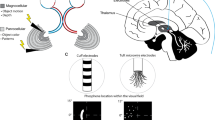Abstract
Cochlear implant has been successfully applied in clinic. Recent research indicates vision implants may be the potential way to restore sight for the blind. Here, principle and common structure of vision implants are introduced. Main vision approaches of retinal, optic nerve, and cortical prosthesis are reviewed. In our progress, electrical response at visual cortex is recorded, when penetrating electrodes stimulate rabbit optic nerve, vision implants based on optic nerve stimulator chip (ONSC) and Chipcon radio frequency (RF) chip are under developing. Despite several obstacles to overcome, promising results in animal and human experiments give scientists confidence that artificial vision implants will bring light to the blind in the near future.
Similar content being viewed by others
References
House W F. Cochlear implants. Ann Otol Rhinol Laryngol, 1976, 85(Suppl. 27, Pt. 2): 1–93
Zrenner E. Will retinal implants restore vision? Science, 2002, 295(5557): 1022–25
Weiland J D, Liu W T, Humayun M S. Retinal prosthesis. Annu Rev Biomed Eng, 2005, 7: 361–401
Becker M, Eckmiller R, Hunerman R. Psychophysical test of a tunable retina encoder for retinal implants. IEEE Neural Networks, 1999, 1: 92–95
Troyk P, Schwan M. Closed-loop class E transcutaneous power and data link for microimplants. IEEE Trans Biomed Eng, 1992, 39(6): 589–599
Liu W, Vichienchom K, Clements M, et al. A neurostimulus chip with telemetry unit for retinal prosthesis device. IEEE Solid-State Circuits, 2000, 35(10): 1487–1497
Nichols M. The challenges for hermetic encapsulation of implanted devices—a review. Crit Rev Biomed Eng, 1994, 22(1): 39–67
Singh P R, Liu W, Sivaprakasam M, et al. A matched biphasic microstimulator for an implantable retinal prosthetic device. In: Proc Int Symp Circuits Syst, Hiroshima, Jpn, 2004, 4: 1–4
Sui X H, Zhang R X, Pei W H, et al. Fabrication of a silicon-based microprobe for neural interface applications. Chinese J Semicond, 2006, 27(10): 1703–1706
Lotfi B M, Joseph F R, David C S, et al. What blindness can tell us about seeing again: merging neuroplasticity and neuroprostheses, Nature Review | Neuroscience, 2005, 6: 71–77
Chow A Y, Chow V Y, Packo K H, et al. The artificial silicon retina microchip for the treatment of vision loss from retinitis pigmentosa. Arch Ophthalmol, 2004, 122: 460–469
Pardue M T, Phillips M J, Yin H, et al. Possible sources of neuroprotection following subretinal silicon chip implantation in RCS rats. J Neural Eng, 2005, 2: S39–S47
Zrenner E. The subretinal implant: can microphotodiode arrays replace degenerated retinal photoreceptors to restore vision? Ophthalmologica, 2002, 216(Suppl. 1): 8–20
Sachs H G, Schanze T, Wilms M, et al. Subretinal implantation and testing of polyimide film electrode in cats. Graefes Arch Clin Exp Ophthalmol, 2005, 243: 464–468
Sachs H G, Schanze T, Brunner U, et al. Transscleral implantation and neurophysiological testing of subretinal polyimide film electrodes in the domestic pig in visual prosthesis development. J Neural Eng, 2005, 2: S57–S64
Humayun M S, Weiland J D, Fujii G Y, et al. Visual perception in a blind subject with a chronic microelectronic crude operations and even see faces they have not seen in many years. retinal prosthesis. Vision Res, 2003, 43: 2573–2581
Lakhanpal R, Yanai D, Weiland JD, et al. Advances in the development of visual prostheses. Curr Opin Ophthalmol, 2003, 14: 122–127
Yanai D, Lakhanpal R R, Weiland J D, et al. The value of preoperative tests in the selection of blind patients for a permanent microelectronic implant. Trans Am Ophthalmol Soc, 2003, 101: 223–228
Guven D, Weiland J D, Fujii G Y, et al. Long-term stimulation by active epiretinal implants in normal and RCD1 dogs. J Neural Eng, 2005, 2: S65–S73
Michael J M, David S H, Rohit R L, et al. Retinal prostheses for the blind. Ann Acad Med Singapore, 2006, 35: 137–144
Humayun M S, de Juan E Jr, Weiland J D, et al. Pattern electrical stimulation of the human retina. Vision Res, 1999, 39: 2569–2576
Rizzo J F, Wyatt J, Loewenstein J, et al. Perceptual efficacy of electrical stimulation of human retina with a microelectrode array during short-term surgical trials. Invest Ophthalmol Vis Sci, 2003, 44: 5362–5369
Eckmiller R E, Neumann D, Baruth O. Tunable retina encoders for retina implants: why and how. J Neural Eng, 2005, 2: S91–S104
Veraart C, Wanet-Defalque M C, Gerard B, et al. Pattern recognition with the optic nerve visual prosthesis. Artif Organs, 2003, 11: 996–1004
Brindley G. The number of information channels needed for efficient reading. J Physiol, 1965, 177: 44–47
Brindley G, Rushton D. Implanted stimulators of the visual cortex as visual prosthetic devices. Trans Am Acad Ophthalmol Otolaryngol, 1974, 78: OP741–745
Dobelle W H, Mladejovsky M G, Girvin J P. Artifical vision for the blind: Electrical stimulation of visual cortex offers hope for a functional prosthesis. Science, 1974, 183(123): 440–444
Pollen D A. Responses of single neurons to electrical stimulation of the surface of the visual cortex. Brain Behav Evol, 1977, 14(1–2): 67–86
Troyk P, Bak M, Berg J, et al. A model for intracortical visual prosthesis research. Artif Organs, 2003, 27: 1005–1015
Fernandez E, Alfaro A, Tormos J M, et al. Mapping of the human visual cortex using imageguided transcranial magnetic stimulation, Brain Res Protoc, 2002, 10: 115–124
Author information
Authors and Affiliations
Corresponding author
Additional information
Supported by the 973 National Basic Research Program of China (Grant No. 2005CB724302)
Rights and permissions
About this article
Cite this article
Niu, J., Liu, Y., Ren, Q. et al. Vision implants: An electrical device will bring light to the blind. Sci. China Ser. F-Inf. Sci. 51, 101–110 (2008). https://doi.org/10.1007/s11432-007-0072-z
Received:
Accepted:
Issue Date:
DOI: https://doi.org/10.1007/s11432-007-0072-z



